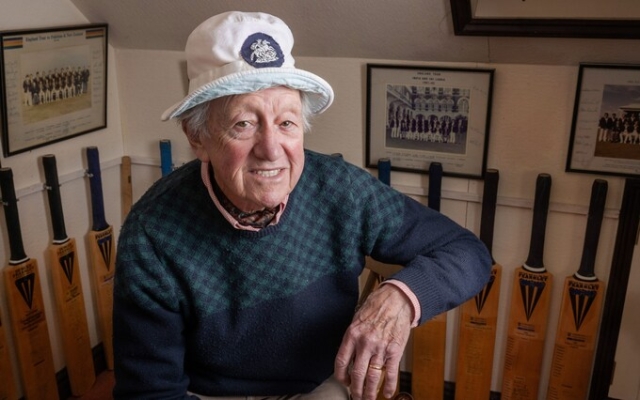 Bob Taylor was always a wicket-keeper first and a batsman second. Photo: PAUL COOPER
Bob Taylor was always a wicket-keeper first and a batsman second. Photo: PAUL COOPER
Bob Taylor jumps out of his seat and joins in with his hands together, catching an imaginary ball and throwing it to make his first slip, a move as fluid at age 82 as it was when he stood with his back to To Bob Willis
Taylor has his office in the delightful stone cottage on the outskirts of the Peak District, near Stoke-on-Trent, where he lived with his wife Katie for 35 years. His office is filled with bats, balls, autographed caps and sports photos, but one item is missing.
Does he have wicket gloves to pose for a photo? “Sorry, I'm not. They are in God's museum.»
Of course, and rightly so, because Taylor holds the world record for most dismissals in first-class cricket, 1,649, a mark that will never go away. be beaten. “Do they play a lot of games now?”
Over the course of an hour-long interview, before Katie serves up soup simmering on the Aga for dinner (sandwiches for the ride home were later gratefully accepted), Taylor talks about her views on the modern game; the most important skill for a top goalkeeper; sympathizes with Ben Fox over his treatment by selectors; remembers Headingley 81 and a cricketer's life, a far cry from the one they lead these days.
«I thought Baseball's hats looked stupid, but then I remembered mine»
Taylor doesn't really know anything about Baseball. “I heard this mentioned in the summer, I still don’t know what it means, but Harry Brooke, he’s a very good player with great technique, who can hit sixes, but when you see reverse sweeps and catches and all that stuff in Test cricket… older players must be turning in their graves.” Bob may not have embraced the reverse scoop, but he has one thing in common with Ben Stokes' team: a love of bucket hats.
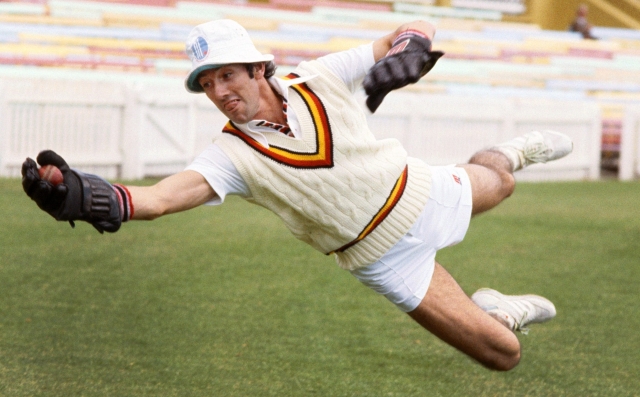 Taylor in his early '80s heyday… and his bucket hat Photo: Getty Images
Taylor in his early '80s heyday… and his bucket hat Photo: Getty Images 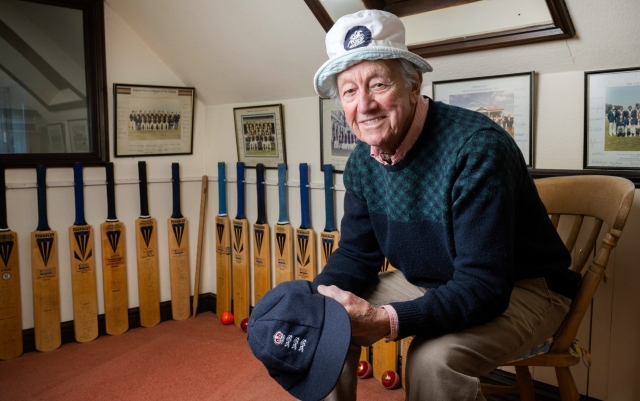 ..And wearing the same hat 40 years later Photo: PAUL COOPER
..And wearing the same hat 40 years later Photo: PAUL COOPER
We joke that he was ahead of his time by choosing a bucket hat rather than a blue England cap. Stokes and the Bazballers made the bucket hat a must-have item for fans during last year's summer Ashes. When they sold out they changed hands on Ebay for several hundred pounds. But when Taylor played for England, the players had to be more creative. No headwear other than the official cap was supplied, so he used a golf cap bought in South Africa (it has a tee storage band) and Katie stitched the St. George and Dragon emblem on the front. If you hold it now, it will be as crisp as a Ritz cracker, which Kathy explains is due to the large amount of starch she had to use to remove sweat stains.
Keepers are known to be very picky about their equipment, and the hat was no exception. “I wore it because the cap put a lot of pressure on my head in the heat, but it was so comfortable. When I saw the English guys wearing them in the summer, I thought they looked a little stupid, but then I remembered mine.” It hangs in the entrance hall and is sometimes worn for gardening which, along with daily walks in the fields around the village, keeps him fit and fit.
Taylor's directions to his cottage said to keep an eye out for the Union Jack and the flagpole on the front lawn, but in fact it was obvious which house belonged to the old cricketer: Father Time's weather vane on the roof. “I commissioned a local blacksmith to do it. Lived there for 35 years.”
It was, of course, at Lord's that Taylor played perhaps his most famous role in Test cricket when he was pulled out of the hospitality tent to replace the injured Bruce French in the Test against New Zealand in 1986. Taylor retired two years later. By then he was working for Test sponsor Cornhill when he took a call from Mike Gatting, the then England captain, who asked if he had any equipment. He showed up flawlessly for the session before Bobby Parks officially intervened. Taylor, who had been retired for two years and had kept wicket at Lord's in 1986 . Photo: Halton Archive
“Shame I never managed to catch one, but I was happy with how it went. The most pleasant thing was to meet Her Majesty again. As she approached the players, she said: “I understand you work for the sponsors, Cornhill Insurance.” «That's right, ma'am.» Then she said, “Would you like to come in?” I need home insurance.»
«In India, I would choose Ben Fox»
For someone with the nickname Chat, there's never a lot of awkward silence in our interviews, but it's in her favorite topic of conversation that Taylor finds her true meaning. He was a throwback: a wicketkeeper with an average of 16 and just one first-class century in 639 matches. A one-club player who spent his career in Derbyshire, where money was always tight, Taylor was Alan Knott's understudy for many years. He gives credit to two men for his Test career: Ian Botham and Kerry Packer. The first because he was an all-rounder, which meant England could select a wicketkeeper with weaker batting skills, and the second for the World Series of Cricket tempting Knott.
Taylor played 57 Tests, the first of which was at the age of 29 as a single. — the rested Knott, the rest 56 years in the period from 1977 to 1984, ending shortly before the age of 43.
His autobiography, published in 1985 and presented by BBC correspondent Pat Murphy, is called Stinging Up, Standing Back. “It speaks to how I evaluate custodians,” he says. “Can they do it standing up?” It only took him 10 pages to wonder why goalkeepers are chosen for their ability to save the ball rather than their ability to keep the ball. “It seemed that behind the stumps the batting of the wicket was more important than his ability,” he wrote. One chapter is called “Hold and Strike.”
“It didn't mean I wasn't trying to hit the ball, and I don't make excuses, but no one, either in Derbyshire or in England, encouraged me to try to improve my batting,” he says. “I've never lost sleep over a stroke. But I would lose sleep if I missed stumps or dropped catches because that was my job. I suppose it would be a different story today, but it still happens. Ben Fawkes, James Foster, Chris Reid and Jack Russell were picked, dumped, picked and dumped. I think this is wrong.”
This is a debate that will become an issue in India. Will Foakes return to replace Jonny Bairstow, who dropped the ball in the summer, or will England opt for Bairstow? In India, standing on stumps on hot days and turning pitches is a devilish ordeal. “I watched the match in Halle when Ben Foakes scored a hundred on his debut. I would have continued with him, but then, as you know, he was abandoned. The only thing I noticed last summer was that Jonny Bairstow was not in good form. He had a serious injury and came back and gained a little weight and that can affect your concentration. I would go with Ben to India, where it's hot and humid all day long.”
He cites an anecdote about Javed Miandad as an example. In the final over of the day in the Pakistan Test, Taylor spotted Miandad coming out of the crease and moving down the wicket towards John Lever. “He turned his spikes at length to prepare the field for Abdul Qadir.” Taylor decided to resist the rest of the leverage, which was harsh. “I hit one on the leg side, tore off the bails and Javed was already out of his crease but Shakur Rana was the square leg umpire.” Taylor smiles. “We know what he ended up getting into [the stand-up row with Mike Gatting in 1987]. When I stumped Javed, Shakur Rana didn't even look. He was looking the other way, so he didn't show it. But I still had the concentration to do it. That's what you have to do as a wicketkeeper: stay on top of things and achieve something.»
Taylor likes Bairstow, whose father David was one of those top wicketkeeper-batsmen once picked early him for England, but there's something about Fox that puts him on another level with the gloves.
He keeps coming back to the word “concentration.” “When I coach kids in goal, I tell young boys: forget what you see on TV when goalkeepers scream and swear. You need to concentrate. It's okay to lift the spirits of your guys, but I said that if you're too busy talking to your opponents or all that stuff, you're not concentrating and you'll let your team down.»
'Spit on the ground, it's disgusting'
Taylor has been keeping in touch with old cricket friends through a messaging group set up in lockdown by former England international Pat Pocock. “It’s called raising a glass. We just say it and exchange old stories. It's a great way to keep track of each other,” he says.
Of course, he has a lot of stories. One of them is Headingley 81, and on his kitchen wall hangs a plaque given to the players who took part in that great Ashes Test at Leeds.
“I still see it now. The new electronic scoreboard showed 500-1. I had two pounds in my pocket, and £1,000 was a lot of money at the time.” But he never made it to the bookmakers. Autograph hunters prevented him from reaching the bookmaker's tent before he had to return to the field. “If I hadn’t signed autographs, I would have gotten there. I didn't want to ask anyone else to bid. Rod Marsh and Dennis Lilley did it. Rod told me they bet the money just like the bettors who thought a 500-1 result in a two-horse race was too good to pass up, but you know, because of Ash's history, they didn't give it away would have them against us.”
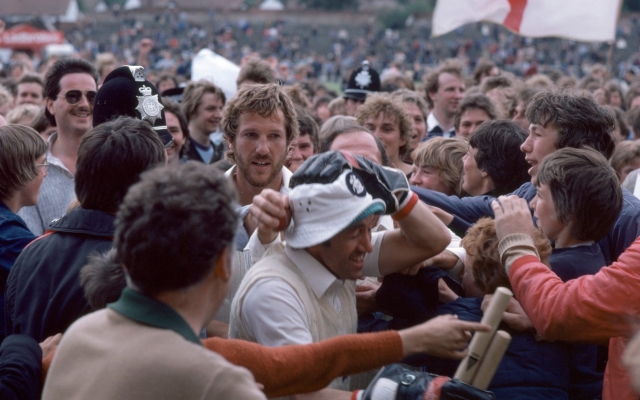 Bucket-hatted Taylor and Ian Botham flee the battlefield after the extraordinary Headingley challenge in 1981. Photo: Popperfoto
Bucket-hatted Taylor and Ian Botham flee the battlefield after the extraordinary Headingley challenge in 1981. Photo: Popperfoto
Taylor is an avowed traditionalist. He is not into white-ball cricket and doesn't know much about The Hundred. He still watches Test cricket and his playing career at Cornhill and then with the Dukes cricket ball company kept him connected to the game for decades after he retired. He trained Jack Russells and also worked at several private schools. He likes the exciting way England are playing Test cricket these days, but he doesn't like some of the modern behavior. “I grew up in the old school and one of the dirty habits I see now is wicketkeepers spitting on the ground. They have to know they're on TV but still do it. It's disgusting. That was one of the things I tried to discourage kids from doing.”
His grandson Jack, who lives in New Zealand, is 12 years old and, of course, is a goalkeeper. “When I was there last year, I took him to the nets to catch and keep wicket and asked one of the Nelson Cricket Club batsmen to keep an eye on him.” And the message? “Just keep your eye on the ball all the time, keep your head down and when the batsman plays the ball, be physically ready to perform the actions of taking the ball. Once you do that, you're ready.”
It's time to stop, although we could continue for another hour. The soup is served.













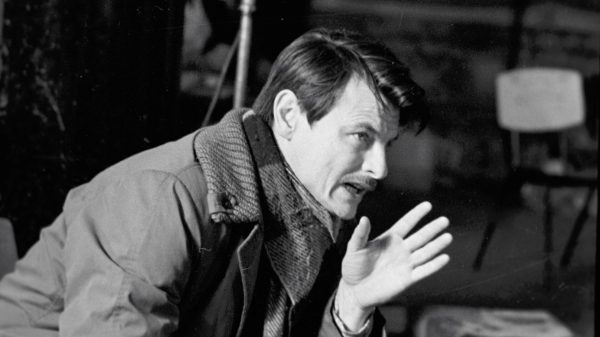






































Свежие комментарии